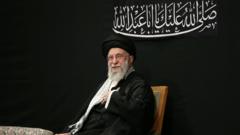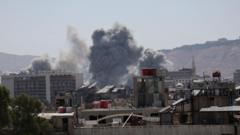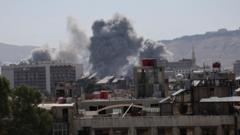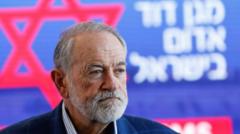In his first public appearance since Iran's recent conflict with Israel, Supreme Leader Ayatollah Ali Khamenei was seen greeting worshippers at a mosque, signaling a moment of solidarity amidst tense national circumstances. His visible presence follows a series of updates concerning Iran's military confrontations, particularly focused on recent military strikes and diplomatic fallout.
Iran's Supreme Leader Reemerges Amid Conflict Tensions with Israel

Iran's Supreme Leader Reemerges Amid Conflict Tensions with Israel
Khamenei appears publicly for the first time since the Israel-Iran war, showing support for his nation.
In a ceremony broadcast on state television, Ali Khamenei greeted worshippers during a day dedicated to a significant Shia festival. This event marked his first return to public life after the onset of the intense conflict that erupted on June 13, resulting in substantial military casualties for both sides. Khamenei's last notable public move was a recorded video address post-ceasefire, amid concerns and rumors regarding his safety and allegations he had been seeking refuge in a bunker during the hostilities.
During the televised gathering, Khamenei interacted warmly with the crowds and senior clerics, urging patriotic songs that had gained prominence during the recent strife. This public demonstration came at a time when Iran was mourning traditional observances connected to the month of Muharram, culminating in the observance of Ashura, a time of remembrance for Shiite Muslims.
In the wake of escalatory strikes on Iranian nuclear facilities attributed to US involvement, Khamenei continues to assert Iran's strength, claiming to have emerged victorious from the recent hostilities despite heavy accusations from Western leaders. As reports mount concerning casualties during the conflict — with Iranian judiciary sources indicating over 900 fatalities — Khamenei's revival in the public domain aims to reinforce national unity and resilience.
Overall, this resurgence highlights a significant chapter in Iran's ongoing narrative in face of external pressures, as Khamenei's determination and symbolic leadership resonate heavily within the country during challenging times.
During the televised gathering, Khamenei interacted warmly with the crowds and senior clerics, urging patriotic songs that had gained prominence during the recent strife. This public demonstration came at a time when Iran was mourning traditional observances connected to the month of Muharram, culminating in the observance of Ashura, a time of remembrance for Shiite Muslims.
In the wake of escalatory strikes on Iranian nuclear facilities attributed to US involvement, Khamenei continues to assert Iran's strength, claiming to have emerged victorious from the recent hostilities despite heavy accusations from Western leaders. As reports mount concerning casualties during the conflict — with Iranian judiciary sources indicating over 900 fatalities — Khamenei's revival in the public domain aims to reinforce national unity and resilience.
Overall, this resurgence highlights a significant chapter in Iran's ongoing narrative in face of external pressures, as Khamenei's determination and symbolic leadership resonate heavily within the country during challenging times.





















